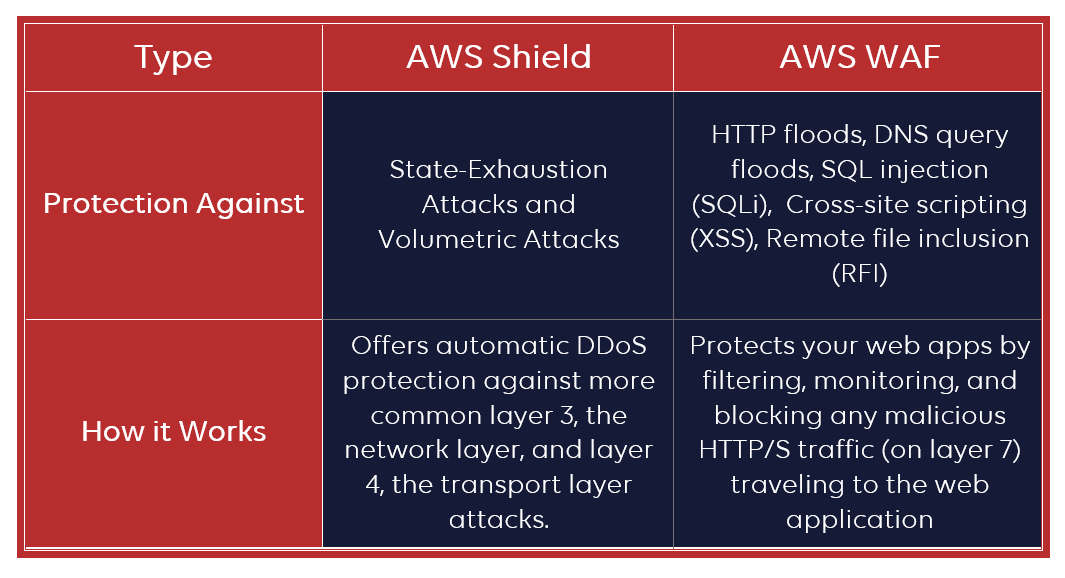Safeguarding Your Web Assets: Unraveling the Differences between AWS Shield and WAF
 Sumit Mondal
Sumit Mondal
Introduction
In the ever-evolving digital landscape, ensuring the security of web applications is paramount. Amazon Web Services (AWS) offers robust solutions to fortify your online presence, with AWS Shield and AWS WAF standing out as key guardians against a myriad of cyber threats. While both play critical roles in enhancing security, they address different aspects of web protection. In this blog post, we will delve into the distinctive features of AWS Shield and AWS WAF, exploring their functionalities, use cases, and the value they bring to safeguarding your web assets.
Understanding AWS Shield
AWS Shield is a managed Distributed Denial of Service (DDoS) protection service that shields web applications from various types of DDoS attacks. Its primary purpose is to ensure the availability of your web applications by detecting and mitigating DDoS attacks in real-time. AWS Shield operates at the edge of the AWS network, allowing it to absorb and mitigate volumetric attacks before they reach your infrastructure.
Key Features of AWS Shield:
Global Threat Environment Monitoring: AWS Shield continuously monitors the global threat environment, leveraging machine learning to identify and adapt to emerging DDoS attack patterns.
Automatic DDoS Attack Mitigation: The service provides automatic and instantaneous mitigation of DDoS attacks, allowing your applications to stay resilient even under intense attack scenarios.
Advanced Threat Intelligence: AWS Shield integrates advanced threat intelligence to stay ahead of evolving DDoS threats, ensuring proactive defense mechanisms.
Cost-Effective Protection: With AWS Shield, you only pay for the DDoS protection you need, making it a cost-effective solution for businesses of all sizes.
Use Case Example: Imagine a scenario where an e-commerce website experiences a sudden surge in traffic due to a flash sale. Without AWS Shield, this spike could potentially be misconstrued as a DDoS attack, leading to downtime and loss of revenue. AWS Shield, however, can distinguish between legitimate traffic spikes and malicious attacks, ensuring uninterrupted service for genuine users.
Understanding AWS WAF
While AWS Shield focuses on DDoS protection, AWS Web Application Firewall (WAF) is designed to safeguard your web applications from common web exploits and vulnerabilities. AWS WAF operates at the application layer of the OSI model, allowing you to define customizable rules to filter and monitor HTTP and HTTPS traffic to your web applications.
Key Features of AWS WAF:
Rule-Based Security Policies: AWS WAF enables you to create and customize rules to filter web traffic based on criteria such as IP addresses, HTTP headers, and URI strings.
Integration with AWS Services: It seamlessly integrates with other AWS services, allowing you to protect applications running on Amazon CloudFront, Application Load Balancers, and API Gateway.
Managed Rule Sets: AWS WAF offers managed rule sets that automatically update to protect against the latest web application security threats, saving you from manual rule adjustments.
Logging and Monitoring: AWS WAF provides detailed logs and metrics, allowing you to monitor traffic patterns and identify potential security threats.
Use Case Example: Consider a scenario where a banking application is susceptible to SQL injection attacks. AWS WAF allows the creation of rules to inspect and block incoming requests containing malicious SQL injection payloads, thus preventing unauthorized access to sensitive financial data.
Key Differences Between AWS Shield and WAF
Focus Area:
AWS Shield primarily focuses on DDoS protection, ensuring the availability of web applications by mitigating volumetric attacks.
AWS WAF, on the other hand, concentrates on safeguarding web applications from common web exploits and vulnerabilities at the application layer.
Layer of Operation:
AWS Shield operates at the edge of the AWS network, mitigating DDoS attacks before they reach your infrastructure.
AWS WAF operates at the application layer, inspecting and filtering HTTP and HTTPS traffic based on defined rules.
Nature of Threats Addressed:
AWS Shield is tailored to defend against DDoS attacks, including volumetric, state-exhaustion, and application layer attacks.
AWS WAF addresses threats such as SQL injection, cross-site scripting (XSS), and other web application vulnerabilities.
Conclusion
In conclusion, the combination of AWS Shield and AWS WAF provides a comprehensive security framework for your web applications. While AWS Shield stands guard against DDoS attacks, ensuring the availability of your applications, AWS WAF adds an additional layer of defense by protecting against common web exploits and vulnerabilities. Leveraging these services together allows you to create a robust security posture, ensuring the resilience and integrity of your web assets in the face of evolving cyber threats. As you navigate the dynamic landscape of web security, understanding the nuanced differences between AWS Shield and AWS WAF empowers you to make informed decisions tailored to the specific needs of your applications.
Subscribe to my newsletter
Read articles from Sumit Mondal directly inside your inbox. Subscribe to the newsletter, and don't miss out.
Written by

Sumit Mondal
Sumit Mondal
Hello Hashnode Community! I'm Sumit Mondal, your friendly neighborhood DevOps Engineer on a mission to elevate the world of software development and operations! Join me on Hashnode, and let's code, deploy, and innovate our way to success! Together, we'll shape the future of DevOps one commit at a time. #DevOps #Automation #ContinuousDelivery #HashnodeHero